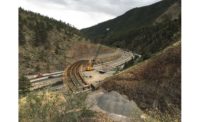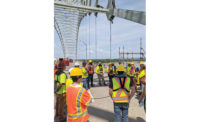Kiewit Could Start I-40 Bridge Permanent Repairs By End of June

US DOT Secretary Buttigieg visited site of I-40 bridge in Tennessee June 3. Photo courtesy of Tennessee Welcome Center via YouTube
Permanent repairs to the I-40 Mississippi River bridge could begin by the end of June, said Tennessee Dept. of Transportation Commissioner Clay Bright, at a June 3 press conference following a day of meetings with U.S. Transportation Secretary Pete Buttigieg and other state and local officials. Repair contractor Kiewit Infrastructure Group has begun procurement of Michael Baker International-designed post-tensioning components and reinforcement plates that will be installed around the crossing's fractured beam, Bright says.
The plan calls for installing the 20,000-ton, 4 ft x 8 ft post-tensioned brackets 150 ft apart to support eight 3-in.-thick rods that can accommodate 3 million lb of stress. Kiewit will then use nearly 3,000 bolts to attach 150-ft long steel plates weighing 53 tons on both sides of the beam.
Fabrication of the materials is currently underway on a priority basis at two plants, Bright said, with delivery to the Arkansas-Tennessee bridge site expected in late June.
Installation will begin immediately and likely take most, if not all, of July. He added that details must be resolved before Tennessee's DOT can finalize a target reopening date for the bridge. The agency has not stated an estimated cost for the expedited repair effort, or where funding will come from.
Meanwhile, Michael Baker International and HNTB are conducting in-depth inspections of the bridge arch and superstructure to ensure no other existing or potential faults were missed during previous assessments. Ultrasonic testing is being used to examine all welds in the main tie girder at locations similar to that of the fracture location, as well as on key members of the overhead truss. That process is expected to take four weeks to complete.
During his remarks, Buttigieg praised state and local officials in Arkansas and Tennessee for coming together quickly to address the fracture and ensure the safety of the 70-year-old upstream crossing that has taken a large share of I-40 bridge traffic. He added that the Federal Highway Administration will review Arkansas DOT’s bridge program to determine whether any issues regarding oversight of inspections need to be addressed.




